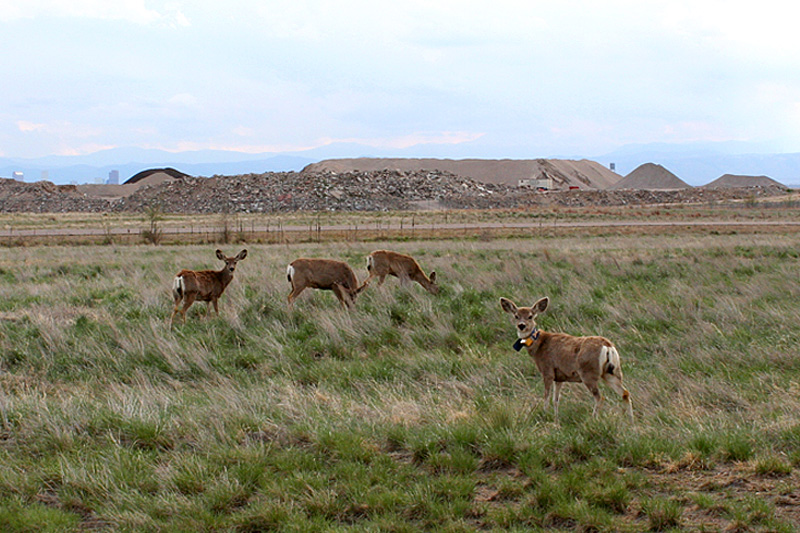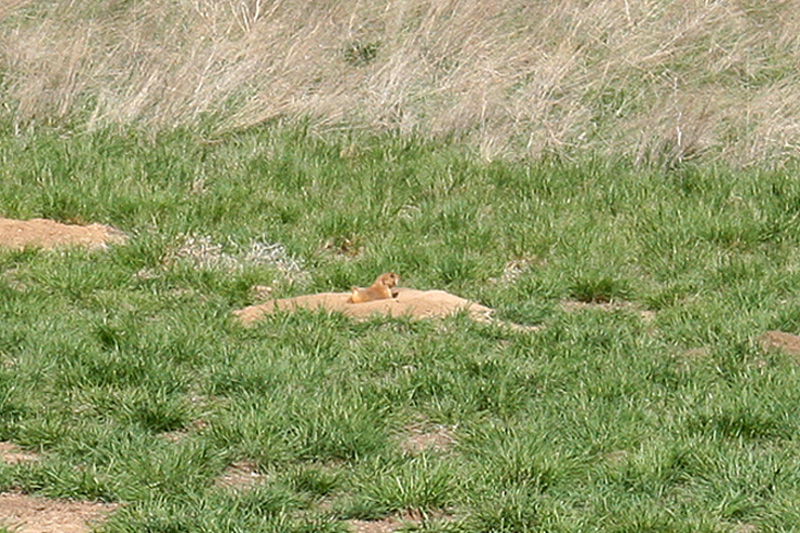Refuge or Not…

It was a bright sunny Sunday and the Aughey’s once again found themselves looking for another adventure to embark on. It was just after lunch so they knew they couldn’t wander too far since daylight would soon be retiring. Art suggested they check out a local national wildlife refuge on the outskirts of town called Rocky Mountain Arsenal National Wildlife Refuge.
Rita was interested in this place because she had read a book that contained some interesting info regarding the site’s history. Consisting of over 17,000 acres, the site’s plains and prairies were once inhabited by plains Indians and settlers. In 1942 the site was transformed into a chemicals weapons manufacturing facility by the US Army. They manufactured mustard and nerve gas, napalm and incendiary bombs for the war. At the war’s end, part of the facility was leased to Shell Chemical Company for the manufacture of pesticides and herbicides.
This manufacturing activity transformed a portion of the site into what was once called “the most contaminated square mile on Earth.” Ducks would die within moments after landing on Arsenal Lake and the bottoms of aluminum boats sent to fetch their carcasses rotted within a month! In 1982 military and civilian production ceased and in 1986 a communal roost of bald eagles attracted by the site’s prairie dog population was discovered within its boundaries. Public interest triggered an intense and successful grassroots effort to have the Arsenal declared a National Wildlife Refuge. In 1987 an environmental cleanup effort was undertaken by the US Army and the Shell Oil Company and is continuing to this day. All the lakes and streams were drained and sealed in an effort to contain the toxic waste and the plan is to continue to treat and monitor toxic groundwater plumes for another century until they’re considered safely diluted.
Art and Rita arrived at the site’s visitor center and were given maps of the trails and literature about the wildlife located on the site. They decided to hike a small portion of trails that surrounded Lake Mary, a smaller lake on the site. As they headed off on the trail they could see numerous animal tracks on the trail, no doubt from wildlife looking for food or water earlier in the day. They saw deer, elk, bird and other assorted tracks. The site is home to over 330 species of mammals, birds, reptiles, amphibians and fish.

Mule deer grazing
They noticed a bird rookery in the middle of Lake Mary that contained some geese and ducks and some strange items they could not make out. Art looked through the binoculars and saw what appeared to be bones of a large mammal consisting of the spine, the skull, and other parts. It was strange because this animal had to swim to the rookery to get to that location and there would be no logical reason for it to do so. Perhaps a larger mammal dragged it there to feed on it? Perhaps it was sick and decided to go to this remote location to die? We will never know.
They continued on the path and came to a portion of the path that was washed out by a slow moving stream. Their choice was to turn back or cross the stream. Knowing most would opt to turn back they decided to cross the stream to access the continuing path where few people would traverse. Farther down the path and out of site of the lake they happened upon a large black-tailed prairie dog town. They quietly observed many of the prairie dogs perched upon their large burrows nervously watching the intruders. The burrows looked like huge ant piles with large holes in the top. The burrows were roughly 3-4 feet in diameter.

Prairie Dog Tunnel
Rita slowly found a place to sit on the outskirts of the town to view the activity with the binoculars while Art strategically sat in the middle of the town hoping to get great photos of them. Most of the prairie dogs retreated into their burrows for safety while several others remained in the holes but still able to watch their intruders.

Art sitting in the middle of the town
One of larger prairie dogs started yipping and barking, no doubt a warning call to the other town inhabitants of the danger within their midst. Their sentry dutifully performed his role for at least an hour while Art and Rita just sat quietly observing their behavior. He did not stop barking the entire time. Many of the other inhabitants either stayed in their burrows or scurried to a burrow farther away. Those on the periphery of the town further away foraged on the grasses while still keeping a close eye on the intruders.

Prairie Dog keeping watch
Prairie dogs are tough, social animals belonging to the squirrel family. Their towns can cover up to 100 acres and consist of underground tunnel systems leading to various neighborhoods or wards. They play an important role in sustaining other prairie life and are therefore considered a “keystone” species. More than 170 vertebrate species depend on them for survival including the bald eagle. The loss of open prairie had dramatically reduced their populations. Since the arrival of European settlers their numbers have plummeted almost 98% prompting a call to the US Fish and Wildlife Service to add them to the endangered species list. This call is currently under consideration.

Prairie Dog Town
Art and Rita decided they had imposed on the prairie dogs long enough and quietly moved away from the town. As they left they heard the sentry’s barks and yips diminish in intensity and frequency until they stopped altogether.
Farther down the path they came upon a second lake where park visitors were leisurely fishing for bass under the park’s catch and release program. Hopefully the fisherman abide by the parks rule of catch and release given the history of the site! It’s doubtful that many know of the dark history of the park.

Rabbit sitting in the entrance to his burrow
Interestingly, the park has a sister site located about 16 miles northwest of downtown Denver called Rocky Flats National Wildlife Refuge and this site has a darker side than Arsenal. Until 1989, the US made plutonium detonators for atomic weapons at Rocky Flats with a shocking disregard for safety. For years, thousands of drums of cutting oil saturated with plutonium and uranium were stacked outside on bare ground. When someone finally noticed they were leaking, asphalt was poured over the evidence. Radioactive runoff frequently reached local streams fed by the Colorado River and radiation periodically escaped into the air. In 1989 an FBI raid finally closed Rocky Flats and several billions of dollars worth of intensive cleanup was undertaken. The asphalt and 3 feet of soil was scraped and sent to a waste processing facility in South Carolina. More than half of its 800 structures were razed, including the infamous “Infinity Room”, where contamination levels rose higher than instruments could measure. Several buildings were mostly underground and therefore buried. Above them, grasses and other herbivorous food sources were planted to assure a habitat for resident elk, mink, mountain lion and other mammals.
Anything at Rocky Flats too hard or too hot to move was covered with concrete and 20 feet of fill and has remained off-limits to humans. When one considers that uranium and plutonium residues have half-lives starting at 24,000 years it’s hard to imagine that this site will ever be safe for humans let alone wildlife. Additionally, underground streams are fed by the Colorado river which starts north of Denver and flows through 5 states eventually exiting into the Pacific in Southern California. The Colorado river is the main water source for those 5 states. Many of the wineries in California and western farmlands derive their water from the river. One has to wonder how much of the toxins from these so called “wildlife refuges” find their way into this water and ultimately into the food sources nourished by this water?
The day drew to a close and Art and Rita once again reached the Visitors Center. They saw many different species of birds and several mammals such as the prairie dogs on their hike through the refuge. It was a bittersweet visit as there was such natural beauty of the lakes, grasslands, etc. However, knowing the history of this site and others like it, they found it extremely sad and disquieting for the wildlife that are unaware of the impact human ignorance has extolled on this otherwise beautiful land.

